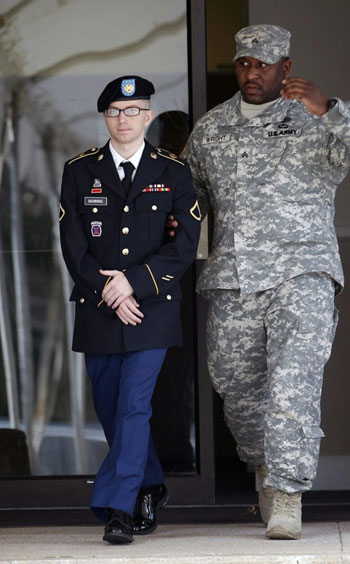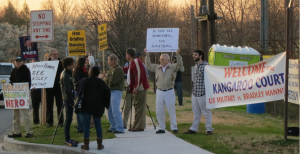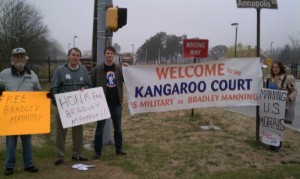
Bradley Manning being led from the Fort Meade courtroom, 15 March 2012
Nathan Fuller, Bradley manning Support network
DAY ONE
Bradley’s attorney insists charges must be dismissed after the government’s refusal to provide vast amounts of evidence and key witnesses. Criticizing “gamesmanship,” David Coombs said the prosecution “has so hopelessly confused discovery in this case so as to prejudice my client.”
By Nathan Fuller, Bradley Manning Support Network. March 15, 2012
I’ve attended Bradley Manning’s pretrial hearing in December, his arraignment in February, and now his motion hearing – all in Fort Meade, but each time has been a little different. Notable new developments this time include a bomb-sniffing dog at vehicle inspection, an announcement prefacing the session that “attire” deemed “disruptive” would warrant ejection, and a Support Network member being denied entry to the base temporarily for wearing a Bradley Manning t-shirt.
Today began Bradley Manning’s motion hearing, a pretrial procedure designed to reintroduce and debate some issues that arose from PFC Manning’s pretrial hearing in December and his arraignment in February. The military judge is expected to announce a timeline for the court martial to come.
The foremost issues discussed today were the defense’s motions to compel discovery and to compel deposition, meaning the evidence and witnesses that were denied at the pretrial hearing.
First, military judge Denise Lind asked PFC Manning if he’d like to retain his current defense team, comprising David Coombs and military officers Bouchard and Kemkes, who was absent today. Manning confirmed that he would. Lind proceeded to summarize the RCM 802 conferences held between Lind, the defense, and the prosecution since the arraignment.
A publicity order was filed and agreed upon, which bars potential jury members from accessing media coverage relating to Manning’s case. Then the judge moved on to the protective order for classified material which is a highly contentious issue but one plagued by the prosecution’s technical issues. The military claimed to have not received vital government emails and that it’s requesting a new email address, and a spam filter had obscured a government email about the protective order. Later on we learned that all emails with the word “WikiLeaks” in them were automatically blocked.
Still, Lind said, the defense and prosecution could not agree on the protective order, as both had filed orders separately. The defense withdrew its request, however, upon learning the prosecution would not reveal “due diligence.”
Bill of particulars — specifying the prosecution’s claims
Lind moved on to the bill of particulars, which the defense filed to force the prosecution to answer questions clarifying and specifying elements of its arguments. Coombs announced that the defense did not understand which documents the prosecution intended to disclose. The prosecution responded that the government had already disclosed all documents except those protected by the classification order.
Then the post-hearing calendar was briefly addressed, but we got few answers about the actual court martial – notably, though, on Bradley Manning’s 660th day in prison without a court martial, the judge assured Coombs that she was “very sensitive” to Manning’s right to a speedy trial. She admonished him immediately after, though, saying that in filing a bill of particulars, Coombs can’t expect to have both reply filings that add time to the proceedings and request a speedier trial simultaneously. Coombs responded that he was not intending to add time but was merely requesting specificity to avoid potential surprises.
Then we moved on to the government’s responses and non-responses to the defense’s questions in the bill of particulars. Asked again, “Who is the alleged enemy?” the government responded, “Al Qaeda and Al Qaeda in the Arabian Peninsula.” Asked how Manning “knowingly” transmit information to the enemy, the government replied that it was via WikiLeaks, on WikiLeaks’ website. The government would not answer “How did Manning get access?” because they believed doing so would require them to preview their arguments to come.
Coombs replied that he was not requesting the government’s legal theory, but merely the facts they’re asserting to make them. Coombs wanted to know whether the prosecution alleged that Manning had hacked into the SIPRnet, or stolen a password, or simply used the access he already had. Before the government could respond, Lind interjected herself, pushing back against Coombs’ question, asking, “Does the government have to prove how he did it?”
Coombs responded that this type of specificity is what the bill of particulars was designed for, explaining, “I don’t want a trial by ambush.”

Members of the Bradley Manning Support Network and other supporters demonstrated outside Fort Meade Thursday.
The government contended that their allegation that Manning accessed the SIPRnet was sufficient explanation. Both sides argued back and forth, with Coombs repeating his reasoning for the request and the prosecution ultimately saying, “It’s not a mystery how he accessed the computer.” The judge ruled in favor of the government, that the given explanation was sufficient.
The whole back and forth was repeated with regards to the ‘Wget’ software, with Coombs asking whether the prosecution alleged it was among the computer’s programs, added with a hard drive, or on the desktop temporarily. No resolution could be reached, so the judge asked the prosecution to produce a forensic expert’s report on the matter.
Next on the bill of particulars, Coombs asked the government whether it alleged Manning had “stolen,” “purloined,” or “knowingly converted” the information. More than a semantic issue, this encompasses the proof required for each theory. The prosecution said it “maintained both theories,” Lind replied that there were three at hand, and the prosecution responded that it made no distinction between steal and purloin. Coombs argued that “purloin” is different in that it requires deception. Lind requested the prosecution produce a more complete answer by March 23.
Motion to compel discovery — the defense requests vital evidence
Lind proceeded to the defense’s motion to compel discovery, starting with an ex parte filing (one which the prosecution doesn’t get to see). The government had asked if the filing was a motion or a supplement, and the defense replied that it was the latter. The government requested that Lind reconsider hearing the motion and instead deny it, which the judge granted. She did note that the defense is allowed to redact the ex parteand submit it openly.
The next motion to compel discovery produced the most extensive controversy. The defense argued that the prosecution fundamentally misunderstands the Brady rule it cites, which mandates evidence disclosure, because it cites Brady’s appellate standard where it means to cite Brady itself. Coombs reminded that he’s been requesting the government’s damage assessments, internal reviews of the alleged damage caused due to WikiLeaks’ releases, since October 10, 2011, but that the government hasn’t provided them. This is especially of concern given Secretary Clinton and Secretary Gates’ public statements acknowledging that very little if any harm had been caused.
The prosecution said it had searched thoroughly for material meeting the Brady standard and had found none it deemed relevant to the defense’s case. But Coombs parsed their argument to elucidate the standard needed: in a motion to compel discovery, the information need only be “material,” or helpful, to the defense. Helpful could mean that it reflected positively on and helped confirm the defense’s argument, or that it reflected negatively and thus informed the defense to pursue alternate arguments. Either way, Coombs said, a damage assessment would clearly be of interest, and that it more than cleared the low bar needed for discovery – a bar, Coombs quipped, so low that you could trip over it. The prosecution, he said, was misinterpreting Brady to force the defense to show how the damage assessment was necessarily relevant to its case, when the assessment only need to be deemed “material.”
Coombs also took issue with the prosecution’s “gamesmanship” regarding the damage assessments. They’re contending both that he needs to prove their relevancy and that they’re irrelevant. They referred to the “alleged” damage assessments, which Coombs said they know full well exist, and are “playing fast and loose with the word ‘completed’,” as these damage assessments could theoretically go on for years. Coombs argued the government “continues to hide behind the complexities of this case.” Deriding the prosecution for “obscuring reality,” Coombs said, “We in the military pride ourselves on not playing games with discovery.”

Vigil for Bradley Manning, outside his motion hearing at Ft. Meade.
Lind didn’t address the Brady standard distinction, and instead asked, “So you’re shifting the burden to the government? You have no burden of proof?” Observing this surprising interjection, the Support Network’s Kevin Zeese said, “the government is fighting Coombs every inch of the way and it feels like the judge really wants to rule against Manning.”
Coombs reiterated his reasoning several times, explaining that the burden of proof would only be on the defense if he was asking to produce the evidence in court. He was motioning, Coombs clarified, only todiscover the material, which requires a far lower bar. Again criticizing the prosecution’s use of the Bradystandard, Coombs said, “Citing the wrong standard for twelve pages is not a mistake. That’s intentional.”
Emphasizing the dire nature of this misuse, Coombs said, “We’re now at a very late stage in the game, with at least two years of applying the wrong standard.” Even if the prosecution were to now hand over the documents, totaling three million pages in all, the defense would need at least an additional six months to review them, further delaying Bradley’s already extremely long pretrial confinement. As Zeese noted, “this discovery battle is critical to the case. If the government can hide the evidence there is no way for there to be a fair trial.”
But Lind didn’t engage that argument either, saying, “I don’t agree that you can ask for anything,” meaning she agreed with the prosecution’s interpretation of the Brady standard.
She then reintroduced the Quantico videos – videotapes of Manning’s abuse at the marine brig, which incurred international outrage. The prosecution stated they did not believe such video exists. Coombs said he’d been given some videotapes but that they were not the tapes he’d requested.
Lind also asked for Allen Milliman’s testimony. Milliman is a network engineer who, at the Article 32 pretrial hearing, discussed his work fixing soldiers’ computers. Without hesitation, Coombs replied, “If we had a verbatim transcript, we could provide that.”
Returning to the damage assessments, the judge asked Coombs why he thought they’d be helpful. He reiterated that the assessments would be of use whether they were positive or negative, and that they would be used with regards to the merits of the case or a potential sentencing argument. He added again that Defense Secretary Robert Gates had publicly claimed no sources were compromised as a result of WikiLeaks’ releases. He took his argument a step further, contending that this was such a fundamental misunderstanding of Brady that it had become “irreversibly” detrimental.
Asked to respond, Ashden Fein claimed that everything the defense is requesting is classified, and thus isn’t subject to discovery disclosure. Fein said the prosecution has options – it could turn the material over, redact it, or invoke the classification privilege – but only if it was deemed relevant could it make a decision.
Lind pressed him on this: “Is there any Brady?” Fein said he didn’t have the authority to answer that question. Lind asked why not, and Fein’s response provoked audible chortles in the courtroom: “Because it’s classified.”
Elaborating, Fein said the prosecution couldn’t comment on the relevance of classified documents, attempting to send the burden of proof back to the defense. He continued, saying the defense had requested four damage assessments, and some of those were “not complete.” Coombs said he requested those that were complete, and pushed back again on the use of “complete,” because “if they’re never completed, they can never be requested.”
Coombs said the government is incorrect in arguing that classification requires proffering necessity or relevance, observing that the prosecution has provided other classified material without the relevance established in court. He said the prosecution’s misunderstanding of their obligations is “beyond curing,” and that the government “has so hopelessly confused discovery in this case so as to prejudice my client.”
“Therefore, I motion to dismiss all charges with prejudice.”
Coombs submitted the motion to dismiss the charges he believed were prejudiced by the lack of evidence, bringing copies to the judge and the prosecution.
Motion to compel deposition — defense witnesses improperly denied from Article 32 hearing
Lind then carried on to the motion to compel deposition – the defense’s filing protesting the denial of witnesses at the pretrial hearing and re-requesting their testimony. He argued these witnesses, Original Classification Authorities (OCA), should be reconsidered for three reasons – (1) their testimony is essential, (2) they were improperly denied from the hearing in December, and (3) the government has impeded the defense’s access to them.
Coombs said these “vital witnesses” were determined to be unavailable for the hearing, despite the fact that two of them were located here at Fort Meade, and weren’t even asked to attend. Instead of asking them, the government had decided independently that they weren’t available, and that the defense’s requests were “premature.”
Coombs explained that he’d asked for the contact information for the two civilian OCAs, to contact them on his own. A month passed with no response, so he asked again — Coombs said the government provided one indirect point of contact, and nothing else.
The prosecution stood to announce several, somewhat disparate explanations for their response to the defense’s request. The prosecution disagrees with the defense on the Investigative Officer’s findings, namely that the deposition denials were improper. Also, the prosecution promised to “endeavor to find” proper witnesses for the defense, and military “housekeeping rules” prevented giving information for those outside the military.
With that, Judge Lind dismissed the court for the day, and scheduled tomorrow’s hearing for 10 AM.
DAY TWO

Vigil outside Ft. Meade for the second day of Bradley's motion hearing.
Military judge denies another motion filed by Bradley’s attorney. After lengthy delay, motion hearing ends with no court martial date set. Next hearing: April 24-26.
Though the second day of PFC Bradley Manning’s motion hearing at Fort Meade was scheduled for 10 AM, extensive private conferencing between the judge, Denise Lind; Manning’s defense, led by David Coombs; and the prosecution pushed the proceedings back to 1 PM. Meanwhile, supporters continued a vigil outside the front gate, holding signs for Bradley Manning.
When the hearing finally commenced, the judge explained that the private conference was devoted to reviewing and discussing an appropriate protective bill for classified information, which shields classified documents from the public in a closed session. Lind announced a protective bill had been “finalized” that “balances” the national security interests of the prosecution and the defense’s right to a fair trial.
Then the judge introduced the two major motions discussed yesterday, the defense’s motion to compel discovery and the defense’s motion to compel deposition. First, Lind said that the motion to compel discovery, or potential evidence, was still “under advisement” and that she will email a decision on it before the next session.
Lind proceeded to the motion to compel deposition – the defense’s protest of the improper denial of witnesses at the Article 32 pretrial hearing. This motion focused on Original Classification Authorities (OCAs), who would testify about the classification of material PFC Manning is accused of releasing, such as three Apache videos. These include Capt. Culkey, Adm. Kevin Donegan, Robert E. Bets, Robert E. Schmittle, Robert S. Harward, Patrick Kennedy, David Woods, and Robert Rolland.
The judge reviewed the defense’s various deposition requests (beginning in October 2010), the pretrial hearing Investigating Officer’s (IO) denial based on “availability,” and the defense’s subsequent appeals and repeated requests. The IO denied the potential witnesses saying they were “unavailable,” meaning the “delay, expense, and impact on the military” if they were to testify “outweighs” their relevance to the case. Part of the military’s definition for “available” means within 100 miles from the court – despite the fact that two of the civilian OCAs are at Fort Meade itself.
In her analysis, Judge Lind ruled against the defense, denying the motion to compel deposition. She argued the IO’s denial was not improper because she agrees their testimony does not “outweigh” the “delay, expense, and impact on the military.” Lind also contested Coombs’ argument that the government had impeded his access to the civilian OCAs, saying that an affidavit was still permissible.
Signaling that this ruling concluded Manning’s motion hearing, Lind scheduled the next court dates for April 24-26, explaining that today’s delays proved that three days were necessary for these hearings instead of two. And less than half an hour since it’d begun, the court was dismissed.
This account
of Bradley Manning’s motion hearing on March 15 and March 16,
2012, is based on Nathan Fuller’s courtroom notes, as no
official transcript is publicly available. Please send questions
or corrections to Nathan(at)bradleymanning.org
HOME